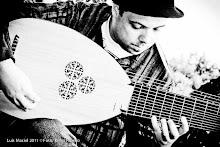 Last week I was told that there was a TV series about the sixteenth century, where a character played Greensleeves on the lute. I understood it should be “the Tudors". I went to a discount store and bought the two seasons that were on sale.
Last week I was told that there was a TV series about the sixteenth century, where a character played Greensleeves on the lute. I understood it should be “the Tudors". I went to a discount store and bought the two seasons that were on sale.Until now, I saw about 7 episodes, and in general I liked, especially for showing lutes in all the episodes and a light music for the instrument in the background of the scenes.
However, of course, I was horrified by the director’s freedom in creating an alternative historical reality to Portugal, when Henry VIII sister traveled to Lisbon, in a computer-made ship (looking like a Roman assault tower) to marry the "decrepit and with gout" Portuguese king. In the end of the episode, the English princess suffocates King Manuel I with a pillow, to run away with the English nobleman, which as all Englishmen of the time, was a model and didn’t have any trace of body hair. The Portuguese court, filled with extras ugly as fear, was a small hall with some tropical themes.
Indeed, in 1520, when the story is set, Lisbon was the capital of Europe, vibrant with trade, art and wealth. At that time the Portuguese Court was the pomp and ostentation, with embassies to the Pope, with elephants and rhinos. Lisbon was the oriental exotism, the spices, the porcelain from China and the pole that distributed the goods in northern Europe and the Mediterranean.
Beyond this surreal moment in the series, I saw that the extras that are playing the lute are not lutenists. Up to episode 6, they all used the instrument with the neck to the right side, and the first episode I saw someone using the lute correctly, the extra was playing as a guitarist and without using the figueta technique.
Historical Consultant: Adelino Costa
(português)
A semana passada disseram-me que havia uma série de TV passada no século XVI, onde uma personagem tocava o Greensleeves no alaúde. Percebi que deveria ser “os Tudors”. Fui a uma loja de descontos e comprei as duas temporadas que havia à venda.
Até agora, vi uns 7 episódios, e no geral gostei, principalmente por mostrarem alaúdes em todos os episódios e leve música de fundo para esse instrumento nas cenas.
No entanto, claro, fiquei horrorizado com a liberdade do director em criar uma realidade histórica alternativa para Portugal, quando a irmã de Henrique VIII viajava para Lisboa, dentro de uma nau feita em computador (mais parecida com uma torre de assalto romana) para se casar com o rei português, “decrépito e com gota”. No final do episódio, a princesa inglesa sufoca o rei Manuel I com uma almofada, para fugir com o nobre inglês, que como todos os ingleses da época, era modelo e não tinha vestígio de pelos corporais. A côrte portuguesa, repleta de figurantes feios como o medo, era um pequeno salão com alguns temas tropicais.
Na realidade, em 1520, na altura em que se passa a história, Lisboa era a capital da Europa, vibrante de comércio, arte e riqueza. Naquele tempo a Corte portuguesa era o fausto e a ostentação, com embaixadas ao Papa com elefantes e rinocerontes. Lisboa era o exotismo oriental, as especiarias, as porcelanas da China e o polo que distribuia as mercadorias pelo Norte e pelo Mediterrâneo.
Para além desse momento surreal da série, vejo que os figurantes que tocam alaúde não são alaúdistas. Até ao episódio 6, todos eles usavam o instrumento com o braço para o lado direito, e no primeiro episódio que vi alguém usar o alaúde corretamente, o figurante estava tocando como um guitarrista e sem utilizar a técnica da figueta.
Consultor histórico: Adelino Costa



Realmente não dá para esperar muitos acertos quanto a esses detalhes técnicos por parte de diretores de cinema ou TV. Uma boa pesquisa faria bem para quem quer colocar instrumentos em cena. Mas acho que mais feio foi uma propaganda que comemorava os 50 anos da bossa nova e mostrava um banquinho e um violão folk, como o pessoal tem usado ultimamente. Resultado: foto bonita, instrumento errado! Normal...
ReplyDelete